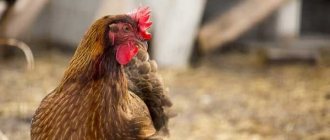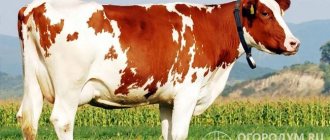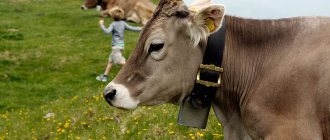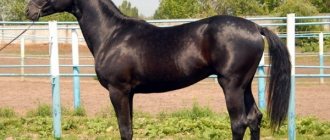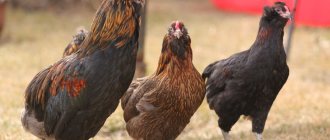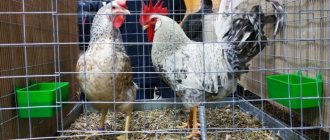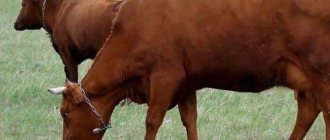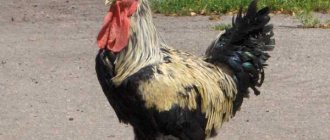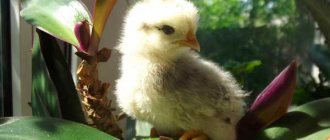The Russian draft horse is the first Russian breed that was originally created as a draft horse, and not from the “it just so happened” series. Before heavy trucks, there were draft horses, which at that time were called “draft horses.” These were large and quite massive animals, closer to the universal type. This was the Kuznetsk horse bred in the 18th century.
But the strong working horse, bred on the basis of the indigenous stock of Western Siberia, did not fully meet the requirements for heavy-duty breeds. This was the reason for its disappearance due to mixing with Western draft horses imported in the 19th century.
Brief description of the breed
The distinctive advantages of Russian heavy trucks are their absolute unpretentiousness in housing conditions and feed, long-term service for the benefit of humans, and high horse productivity. The last parameter indicated concerns the production of dairy products. Mares of this breed produce a large volume of milk, from which rare varieties of cheese are produced. Externally, the horses of the Russian Draft breed are famous for their medium size and at the same time light head with a wide forehead, which sits on a short muscular neck, thick, luxurious hair in the mane and tail, as well as long brushes on the limbs. The horse's physique is characteristic of heavy draft horses: a long strong back, a dry constitution, short strong limbs, a flat loin and fairly wide withers.
The horse's spectacular appearance and high working capacity make it indispensable in management and farming. Today, Russian Heavy Draft horses are divided into three subspecies:
- Ural type of horse , which differs in elongated limbs covered with voluminous hair.
- A massive type of horse that is large in size compared to other draft horses.
- Novoalekseevsky type of horse , visually similar to the massive type, but slightly smaller in parameters.
The calling card of a horse of this breed is unshakable endurance, calm, good disposition, and obedience to the owner.
Read about other Russian breeds of heavy trucks:
- Soviet heavy truck
- Vladimir heavy truck
- Novo-Alexandrovsky heavy truck
Boulogne horse
The breed is ancient, recognized in the 17th century. Bred in the French province of Boulogne. There are 2 types: large heavy and small. Boulogne heavyweights have the following characteristics:
- height at withers - 1.50–1.65 m;
- weight - 0.7–0.9 t;
- the head is graceful, with a regular profile and a high forehead;
- neck - with well-defined muscles;
- thoracic region - deep, with rounded ribs;
- back - wide, flat;
- limbs - strong, short, muscular;
- tail - set high, thick;
- mane - wavy, short;
- color - gray (basic), rarely bay, red;
- disposition - kind.
Advantages:
- increased performance;
- unpretentiousness;
- well-developed musculoskeletal system;
- ability to develop high speed;
- endurance.
The disadvantages include the fact that the breed has practically disappeared.
History of the breed
About one century ago, the Russian people began to actively select the Russian Heavy Truck breed. The first ancestors of horses are recognized as the ancient Ardens, who lived in the Belgian mountains. At that time, these animals did not look the same, and many shortcomings were recorded in the exterior. At the same time, the Ardens quickly covered distances, and their appearance was transformed by their dry constitution. People quickly found a common language with these horses, as they ate any food with a special appetite and felt great in any living conditions.
The Russians appreciated such unpretentious horses; as of 1904, about 376 farms were engaged in breeding Ardenes. The largest horse breeding enterprises are the Khrenovsky and Derkulsky stud farms. All owners and employees of stud farms tried in every possible way to spread this breed of horses. And in order to eliminate the shortcomings of the Ardennes, they were regularly crossed with various glorious horses, in particular, with Brabançons.
Such work was not in vain; over the years, the Ardens began to look much more impressive and demonstrate better qualities. The world exhibition taking place in Paris in 1900 did not pass without a trace for these horses; Ardens were singled out as worthy working original horses. In particular, the male named Karavai, a brown horse of this breed, received the admiration of the audience. He was even awarded a gold medal as the most valuable graduate of the Khrenovsky equestrian class=”aligncenter” width=”800″ height=”561″[/img]
In Belgium itself, the breed was suppressed by another more powerful horse - the Belgian working breed. And the Russian people made every effort to preserve representatives of the Arden breed. Horse breeding has set a goal to breed a short working horse that can work for the benefit of the fatherland, while being unpretentious and hardy.
Many horses became breeding producers in the selection and development of a new breed, in particular horses named Karaul, Larchik, Rubicon and Podenschik.
The bred population of new horses was significantly different from the Ardennes previously familiar to the Russian people. At the onset of 1952, the Ministry of Agriculture of the Soviet Union issued a decree stating that the breed should be designated by the name - Russian Heavy Truck.
What's the best way to buy?
Heavy trucks are purchased both from stud farms and from private farms. As for pricing, it is influenced by the purity of the family, age characteristics, and exterior. It is believed that elite representatives of heavy trucks are purchased at the factories of Vologda, Kueda, and in the Yekaterinburg society “Druzhba”. Applications are submitted in advance, distribution occurs in late summer, early autumn.
For information about what this breed of horse is used for, see below.
The Russian draft horse is the pride of domestic horse breeding. Russian and Ukrainian scientists worked on its breeding and improvement, and the selection work itself dragged on for almost a hundred years. The breed was registered in 1952. We will talk about its origin, characteristics and advantages further.
Russian draft horse
Lifestyle in nature
In order to find an approach to such a horse, you need to know its basic character traits, maintenance and care requirements, as well as food preferences.
Character and habits
The nature of the Russian heavy truck is simple - unprecedented endurance, recognition and obedience to people, a high rate of mobility and energy. Thanks to these characteristics, the horse is ideal for agricultural work. A calm and balanced horse quickly gets used to its new owner, adapts to any living conditions within reason and quickly fits into the work schedule. But if something goes wrong, the horse can show its character by bucking slightly.
Breeding and maintenance
If there are about 100 Russian draft mares on a farm, they account for about 85% of the foal litter. In addition, one mare is capable of breeding offspring for 20-25 years. Mares and stallions are bred and kept on village farms, where the animals undergo training sessions and demonstrate their skills. After which the breeder easily selects the most able-bodied stallions and promising mares.
Horses are considered early maturing producers; already at the age of 1.5 years the stallion reaches full height at the withers, comparable to an adult. At this age, 75% of stallions also gain the desired body weight. And already at the age of three they stop growing. A horse will need a free open-air enclosure in the form of a tent.
Nutrition
Despite their unpretentiousness and easy adaptation to weather conditions, Russian draft horses need plenty of water. Any vegetation that other horses prefer will be suitable as food. Heavy trucks will be happy with any food, despite its high cost and value. This can be fresh grass, hay, solid food and grains. To maintain energy and performance, horses can be fed with concentrated feed, vitamins and minerals. Horses love carrots, beets and sugar, which is often encouraged.
Clydesdale (Scottish Coldblood Horse)
The breed appeared in the second half of the 18th century. Her homeland is Scotland. The unusual exterior made it possible to use the horse not only for heavy work, but also for participation in ceremonies. Characteristic features:
- height at withers - 1.67–1.84 m;
- weight - 0.82–0.91 t;
- the head is powerful, with wide frontal lobes and muzzle;
- neck - elongated, with a good bend;
- thoracic region - deep, with steep ribs, girth 165–205 cm;
- back - shortened;
- limbs - straight, with correct positioning and well-developed brushes;
- tail - straight hanging, not too long, distinguished by splendor;
- mane - straight-falling, lush;
- color - bay, brown, black, with white spots in the area of the head and limbs, which can cover the lower part of the body;
- character - good-natured, balanced.
Read more: Should you get a ferret? Ferrets at home: pros and cons Is it worth having a ferret in an apartment reviews
Advantages:
- endurance;
- high load capacity;
- good adaptability to any natural conditions;
- elegant exterior.
Flaws:
- damp feet;
- the need for high-quality care and feeding.
The use of Russian heavy trucks
In recent years, Russian heavy trucks have been purchased en masse by private farmers seeking to carry out the breeding development of the breed. Due to the high productivity of mares of this breed, many farmers produce kumys and rare varieties of cheese. In this case, the owners keep a large number of mares, which, due to adequate nutrition, give worthy offspring and take care of their brood.
Many stud farms own Russian Draft horses for meat, as well as a large volume of milk. One full-fledged mare per year is capable of producing about 3 tons of milk during lactation. As practice shows, such milk yield indicators are demonstrated by all mares of different breeds of heavy draft horses.
The Russian draft horse is ideal for the tourism business, as these horses demonstrate endurance, good nature and strength. Horses ride children and adults without resting for half a day, especially after sweet treats as rewards.
Features of reproduction and maintenance
One of the biggest advantages that determines the value of this breed is its excellent ability to reproduce and long active life. Producers can be used for breeding until they reach their 25th birthday. If the conditions are well organized, then the percentage of foals is more than 90 . The milk production of female mothers is also very high, about 3 thousand liters during the feeding period.
Another positive quality is the rapid maturation of individuals. At 3 years old they are already capable of producing offspring, but even after one and a half years they are practically indistinguishable from adults in appearance, height and weight. These features make it possible to use them as workers quite early. In addition to all that has been said, heavyweights are not too demanding in their care, they are not picky about food, and the most modest conditions are enough for them. They eat grass, hay, straw, and concentrates.
It has already been proven that heavy trucks are able to search for and get grass under the snow, that is, engage in grass growing.
Photo gallery
Ordinary Russian heavy truck
Russian heavy truck in greenery
Huge Russian heavy truck
How much does a Russian heavyweight cost?
Before you start purchasing a Russian Draft stallion, you should choose an experienced breeder who has been working with such horses for a long time. Only in such a situation can the buyer not worry about the health and thoroughbred status of the horse according to the standards.
The Prilep breeding stud farm is considered the most popular in terms of sales of Russian heavy draft horses; for several decades they have been breeding real heavy draft horses. You can get an animal at a good price if the tribe is liquidated. As practice shows, in such situations horses were sold for 1-1.5 thousand US dollars. When choosing a horse supplier, an important role is played by the location and distance of the farm or factory from the customer’s residence.
Russian heavy truck today
Currently, almost all stud farms are going through difficult times, many of them simply go bankrupt and are forced to sell horses for next to nothing. In general, heavy trucks are unpretentious animals, sold at an average price, which many people will be able to afford. Due to this, under the Soviet Union, the development of such a business was supported by state support. Unfortunately, today's private owners can only rely on self-sufficiency.
Due to a lack of funds to support farming, many horse breeding enterprises are losing their technical base, reducing their livestock to a minimum. Lack of food affects their size; young animals grow smaller and have weaker characteristics. Today, statistics show a reduction in the number of Russian heavy trucks by 3.5 times. And only with the help of enthusiasts is the breeding work to preserve the breed somehow supported.



